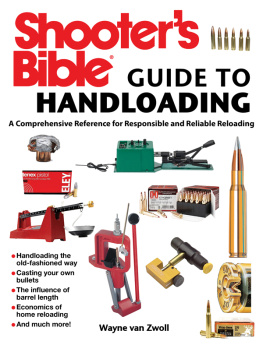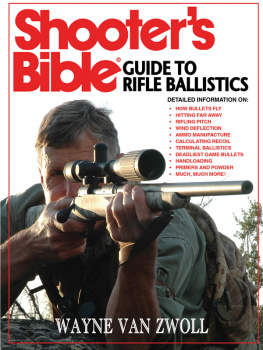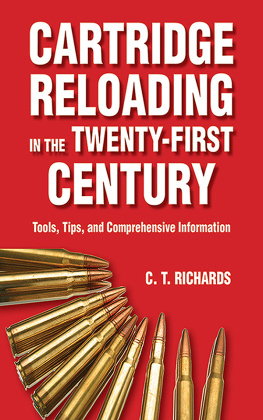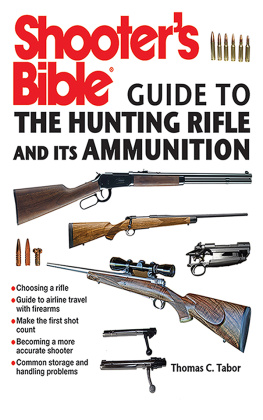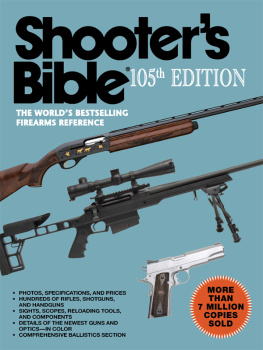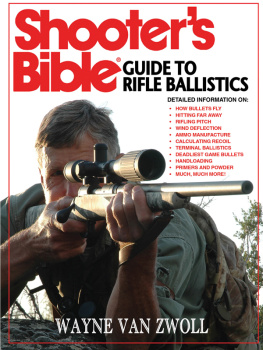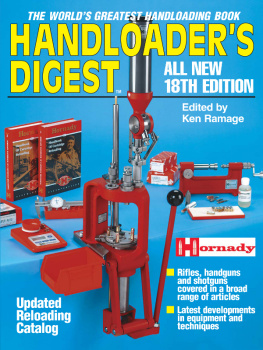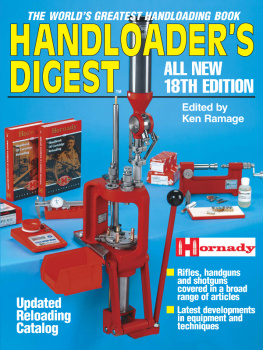Copyright 2015 by Wayne van Zwoll
All rights reserved. No part of this book may be reproduced in any manner without the express written consent of the publisher, except in the case of brief excerpts in critical reviews or articles. All inquiries should be addressed to Skyhorse Publishing, 307 West 36th Street, 11th Floor, New York, NY 10018.
Skyhorse Publishing books may be purchased in bulk at special discounts for sales promotion, corporate gifts, fund-raising, or educational purposes. Special editions can also be created to specifications. For details, contact the Special Sales Department, Skyhorse Publishing, 307 West 36th Street, 11th Floor, New York, NY 10018 or .
Skyhorse and Skyhorse Publishing are registered trademarks of Skyhorse Publishing, Inc., a Delaware corporation.
Visit our website at www.skyhorsepublishing.com.
10 9 8 7 6 5 4 3 2 1
Library of Congress Cataloging-in-Publication Data is available on file.
Cover design by Brian Peterson
Print ISBN: 978-1-63220-287-1
Ebook ISBN: 978-1-63450-971-8
Printed in China
CONTENTS
AUTHORS NOTES AND ACKNOWLEDGMENTS
P roducing this book kept me from having fun for many, many months. If the effort justified such deprivation, it should be apparent. You should find this book both entertaining and useful, and find that it cuts across the brands to which all handloading manuals are slaves. You should find here the best techniques, tools, and components, from a sweep of industry sources. Youll revisit handloading pioneers now gone and look over the shoulders of ballisticians who run sophisticated laboratories that yield current data. The text owes much to veteran hunters and competitive marksmenand womenwho routinely put several bullets through one hole in paper. You should come away, too, with ideas for better ammunition to ring steel targets bent by mirage in a distant zip code.
If the words and photos fail to deliver, its my fault. To the extent they make this book a good buy and, eventually, one of the most-consulted tomes in your library, its because many people contributed. I cant name them all, so I wont bore you with a list. Some are identified in the text, but countless others have taught me much about handloading and shooting. This is indeed an industry rich in both history and talentand full of selfless souls willing to share their expertise. I thank them all most sincerely.
Of course, Im indebted to Earl Wickman, who gave generously of his coaching when, pretzeled over the iron aperture of a Remington 40x, I made every youthful blunder possible in my halting progress toward competence behind a trigger. And I owe Alice, who warned me repeatedly that writing this book would make me surly, unreasonable and fat. She was right.
Wayne van Zwoll
INTRODUCTION: HANDLOADING
H andloading saves you money. I wondered about that four decades ago, my fist tight around the $15 demanded by Herters for its iron C press. Heavy enough to anchor a light destroyer, it crowded the counter of the 28-foot mobile home I occupied during graduate school. A 50-pound keg of surplus H4831 came my way for $150. With barely enough cash left for primers, bullets, tomato soup, and the months rent, I plunged into handloading. In my .270, a reworked Mauser, a 130-grain Sierra pushed by 59 grains sent mule deer to the Great Beyond. I shot my first elk with a 180-grain Speer over 69 grains in a .300 H&H, another rebarreled 98.
Whether you handload for rifles, handguns or shotguns, you get real value for your efforts. While many concepts and practices transfer from metallic cartridges to shotshells, this book treats rifle (mainly) and pistol loads.
BEYOND ECONOMICS
Handloading wrings potential from cartridges neglected or hamstrung by factories with an eye to profits and litigation. My recipe for 87-grain Sierras in the .250 Savage produces half-minute groupsthree times the precision of commercial loads. IMR 7828 powers Noslers from my .264 Winchester 300 fps faster than chart speed. Handloading the .45 Coltfactory-loaded to squib speeds for the gaggle of old and cheap revolvers so chamberedgives it muscle in stout handguns like those by Freedom Arms.
Want more reasons to handload? Its fun. Its a personal investment that hikes the satisfaction you get from each shot. And it pulls you away from the television screen, where people who know nothing about ammunition march in lockstep with the equally ignorant on crusades to disarm you. Handloading calms you, reminds you that the Second Amendment still matters to the legions of fellow enthusiasts who built your press, machined your dies, punched the flash-holes in those cases, and turned the cannelures on your bulletsand to many millions more who share your passion for shooting, collecting and studying the history and mechanics of firearms. Handloading imbeds you ever more deeply in this clan (women included!), while distinguishing you from the great unwashed who simply pull triggers on commercial ammunition.

The author has long handloaded the 7x57. He killed this Oregon buck in the 1970s with a 145-grain Speer.
In my 40 years at the bench, the growing market power of handloaders has produced a cornucopia of hardware and components. The last couple of decades alone have yielded hundreds more bullets and powders in cartridges only the clairvoyant among wildcatters might have imagined in my youth.
Now, cursed be the scalawag who dismisses the factory load as fodder for infidels. I shoot a lot of it. And over my shooting career, its been much improved. Bullet velocities once viable only with primer-flattening handloads now grace shop shelves. Bullet types range from the varmint-vaporizing to cohesive champs that drive laser-straight through the muscle and bone of creatures the size of chest freezers, with enough leftover romp to sever an oak limb and lace a Peterbuilt engine block.
Handloading requires your time and a bit of study. You have the timethe regulation 24 hours everyone gets each day. Study is simply an extension of passion. You are a shooter, arent you?
Like racing motorcycles, skydiving and snorkeling with sharks, handloading is not as dangergous as it might appear to the uninitiated. But because handloading puts you close to things that could impair or abbreviate your life, youre smart to mind these caveats:
YES, YOU CAN TRY THIS AT HOME. BUT
Handload only if you can honestly claim a reasonable level of intelligence, proof of which is your willingness to read all caveats twice, take them to heart, and admit in all humility that, no matter how long youve been shooting or how many times youve pumped a press handle, you do not know all there is to know about handloading. And wont. Ever.
At the bench, focus on the job, not the clock. Hurry-up handloading results in sloppy work and substandard ammunition. It can cause mistakes that ruin costly rifles and leave you thoroughly bandaged when youd as soon look unblemished. Store components only in original containers. No, you will not remember you put 4198 in that empty 4831 canister. You will not tell at a glance the difference between 140-grain .270 spitzers and the 140 7mms you dumped in the .270 box. Mix-ups are embarrassing at best; they can be lethal.
Keep an organized bench. Working up starter loads for a new cartridge, youll likely charge only a few cases between changes in powder type. Permit just one canister on the bench at a time. Finishing with that propellant, dump all remaining powder from the measure (or, if you adopt my habits, the plastic pepper shaker) into the original canister. Close it. Put it away. Ditto the bullets.

